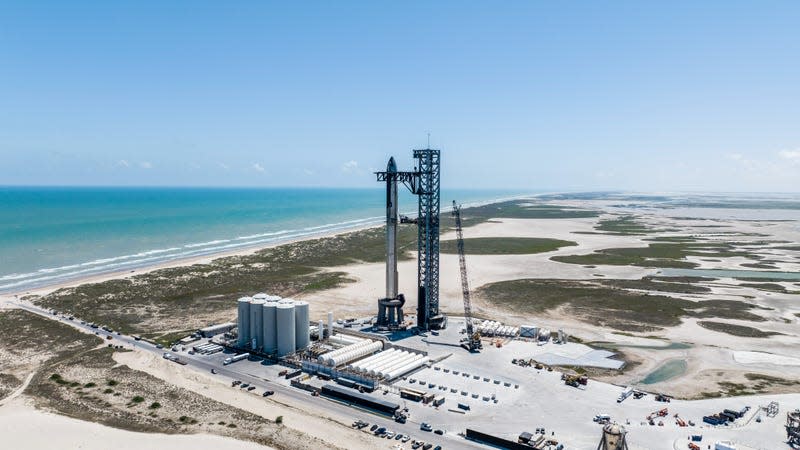FAA’s Mandated Starship Fixes Carried Out by SpaceX, Musk Claims

- Oops!Something went wrong.Please try again later.
Starship at the launch mount in Boca Chica, Texas.
The second test flight of Starship could happen sooner rather than later, with SpaceX CEO Elon Musk claiming that dozens of FAA-requested corrective actions have already been implemented.
Musk announced on September 10 via X, formerly Twitter, that SpaceX has “completed & documented the 57 items required by the FAA for Flight 2 of Starship.” The proclamation arrived just two days after a directive from the Federal Aviation Administration instructing SpaceX to address 63 corrective actions before being granted a launch license for the next Starship flight.
Read more
LeBron James, wife and 2 associates named in federal PED investigation
Starfield Contains A Magic Mud Puddle That Will Make You Rich
Lauren Boebert to Staff at Local 'Beetlejuice' Musical: ‘Do You Know Who I Am?’
Drew Barrymore gets booted from award show hosting gig amidst strike backlash
Starship’s inaugural launch on April 20, during which the rocket flew for roughly four minutes before tumbling and exploding over the Gulf of Mexico, endured several setbacks, including significant damage to the launch mount, widespread debris, disruptions to the local wildlife, the inability of its two stages to separate as planned, and a malfunctioning self-destruct sequence. While Musk’s aerospace company characterized the demo as a success owing to the vital data gathered on the rocket’s performance, both SpaceX and the FAA highlighted the need for multiple corrective actions.
To that end, the aerospace company undertook a series of modifications, including a redesign of vehicle hardware to prevent leaks and fires. The launch pad received notable upgrades, like steel reinforcements and a new water deluge system to withstand the force from Starship’s 33 Raptor engines. These enhancements, coupled with other corrective measures, will presumably undergo further scrutiny by the FAA.
Musk’s tweet on September 10 further elucidated the corrective actions he claims have been completed. Some of the items listed included the addition of over 90 cameras to detect booster leakage, better tank sensing, stronger booster bolts, backup wires, added insulation, more methane sensors, increased scrutiny on leak checks, flight safety system design improvements, and a change to the Raptor engine shutdown logic, among others. More intricate specifics of the mishap investigation report remained confidential due to the presence of proprietary data and U.S. export control regulations (i.e. to prevent U.S. adversaries from gaining access to this sensitive technical info).
The goals of the second Starship flight will repeat those of the first, with SpaceX aiming to send the vehicle’s upper stage on a partial orbit around Earth, and a subsequent splashdown near Hawaii in the Pacific Ocean.
SpaceX’s Starship is designed as a fully reusable spacecraft intended for a wide range of missions, from deploying satellites, shipping cargo, and landing on the Moon and Mars. The company is currently working under multiple NASA contracts, requiring SpaceX to demonstrate Starship as a feasible human landing system for the space agency’s upcoming Artemis missions to the Moon.
Want to know more about Elon Musk’s space venture? Check out our full coverage of SpaceX’s Starship megarocket and the SpaceX Starlink internet satellite megaconstellation. And for more spaceflight in your life, follow us on X (formerly Twitter) and bookmark Gizmodo’s dedicated Spaceflight page.
More from Gizmodo
Well, of course Bill Maher is bringing his show back without its writers
Unity Bosses Sold Stock Ahead Of Scummy Dev Fees Announcement
Rick And Morty star Justin Roiland facing allegations of sexual assault in new report
Sign up for Gizmodo's Newsletter. For the latest news, Facebook, Twitter and Instagram.

